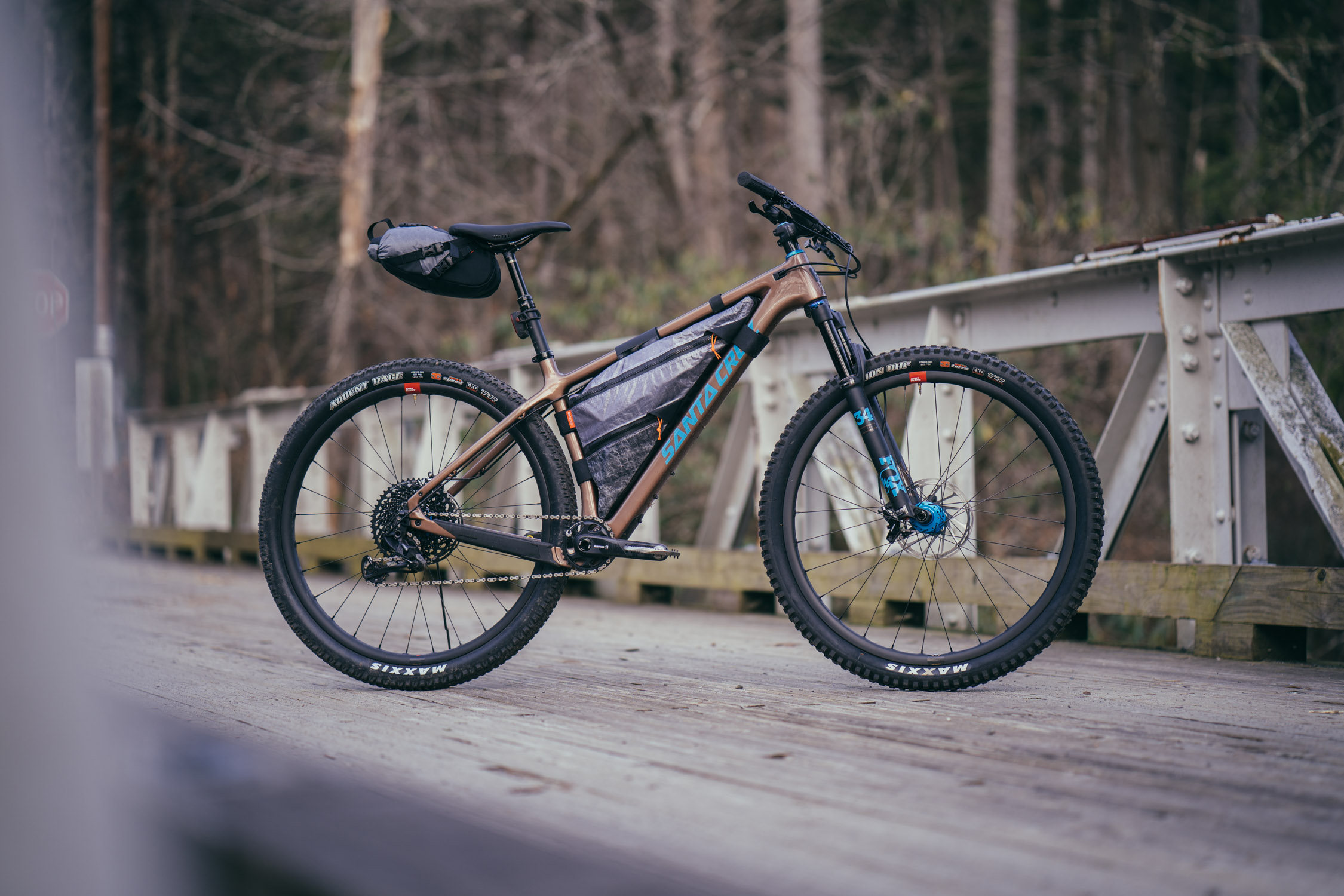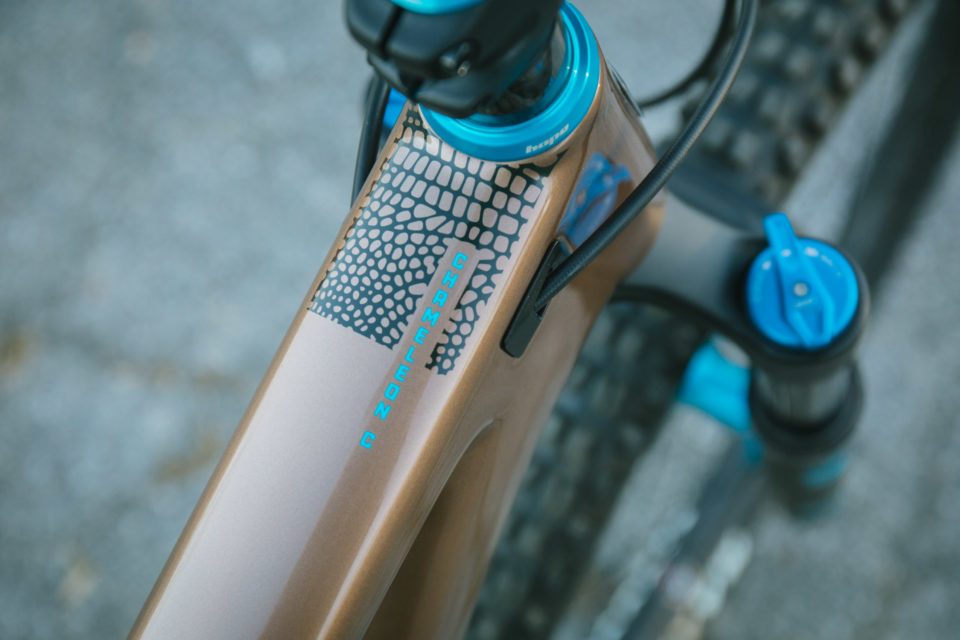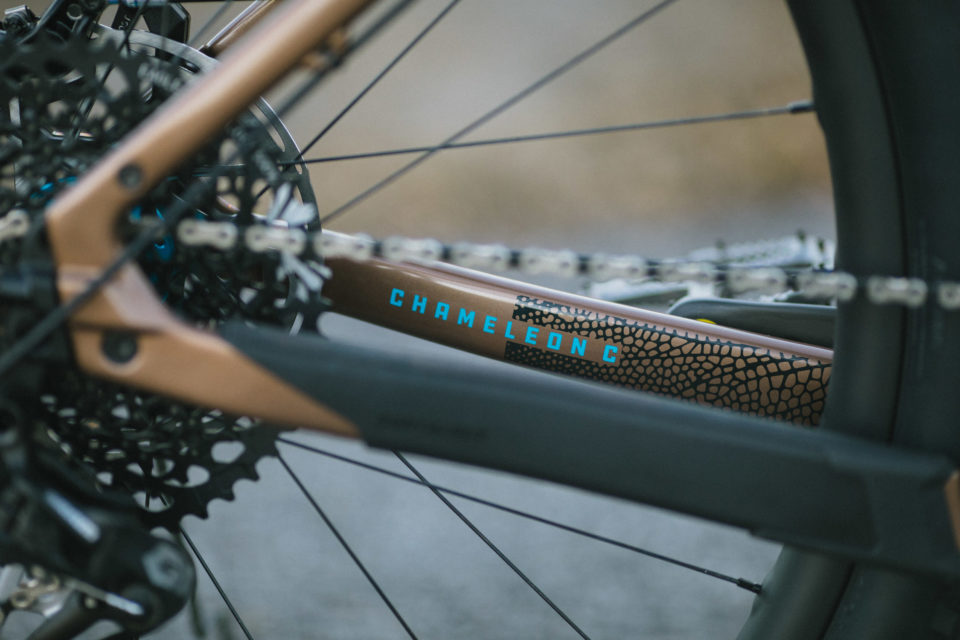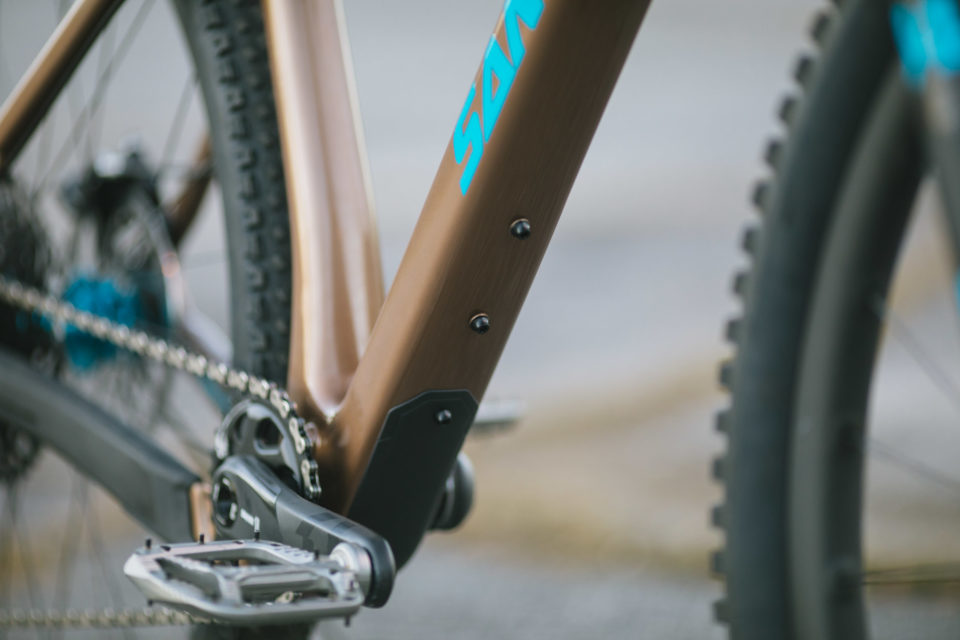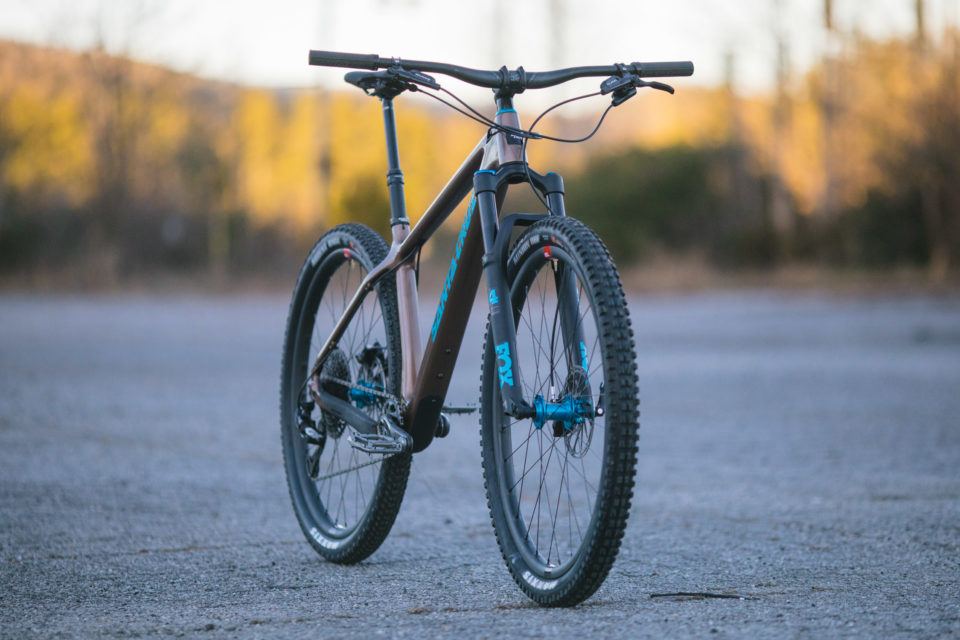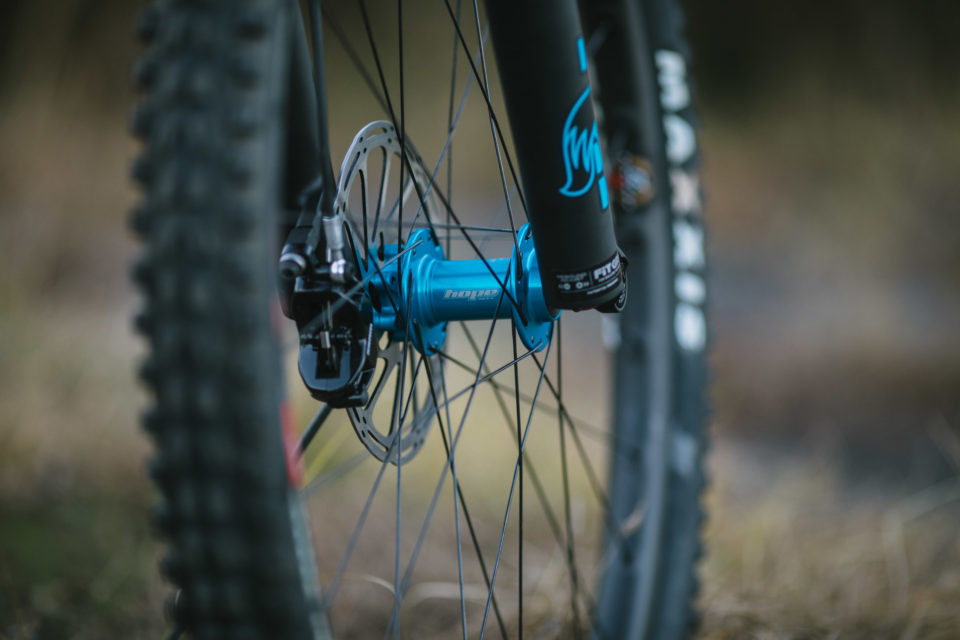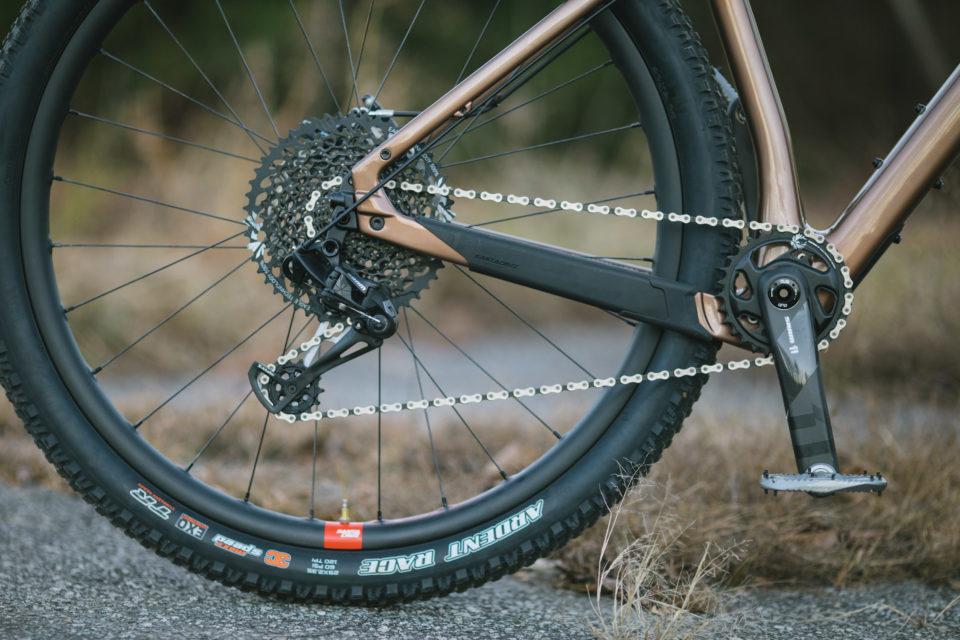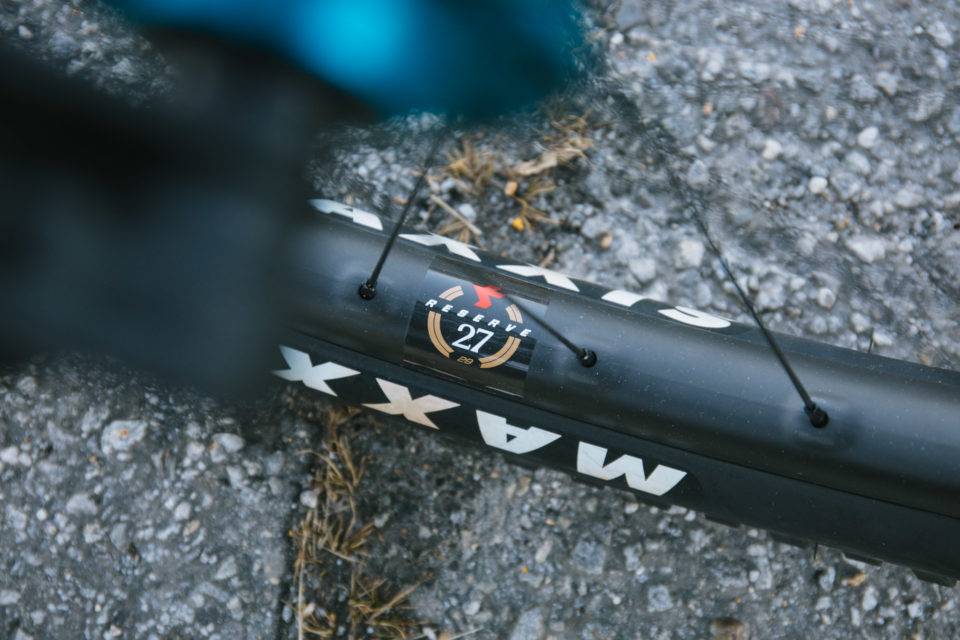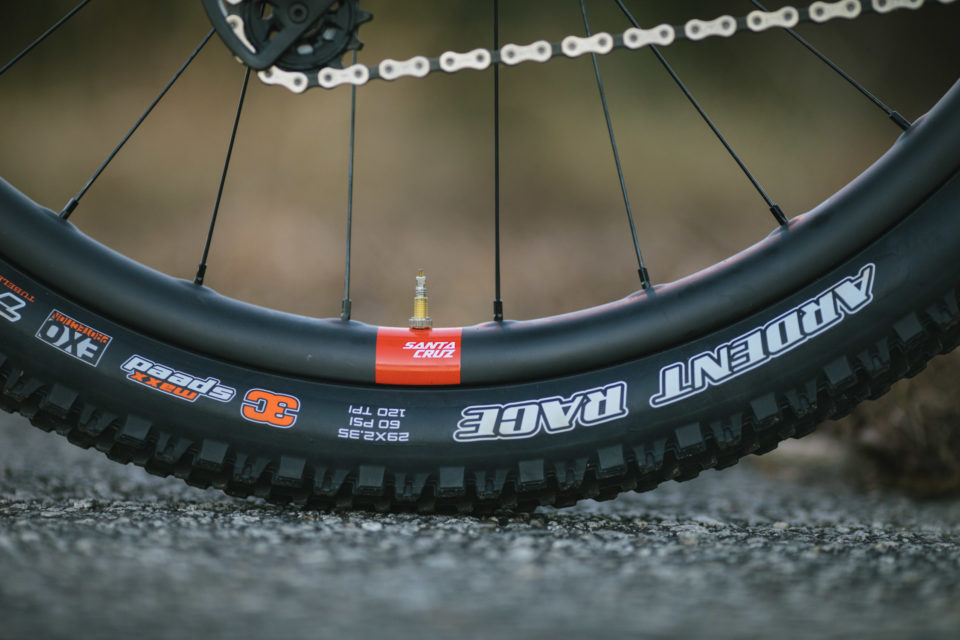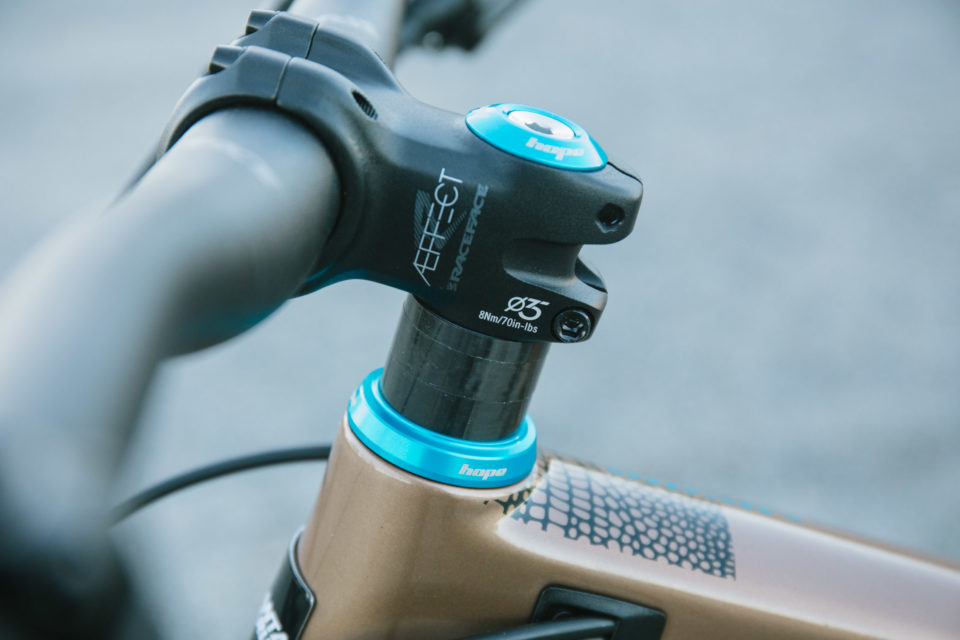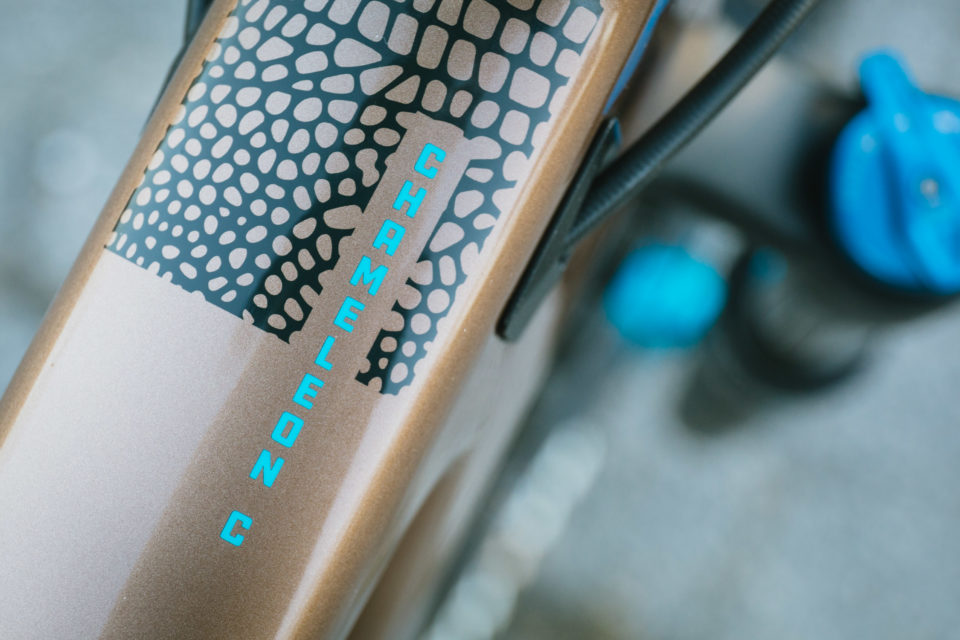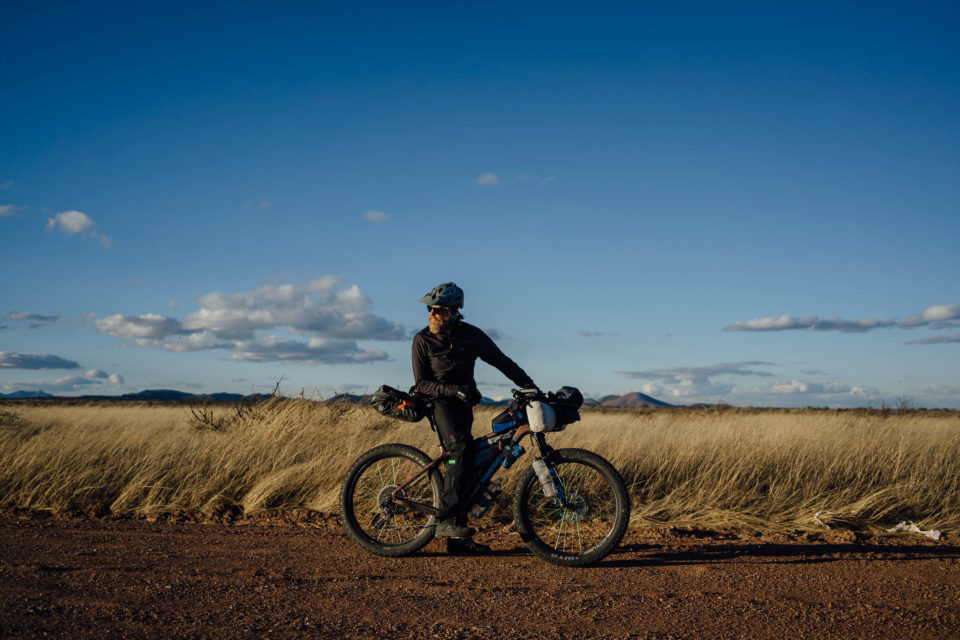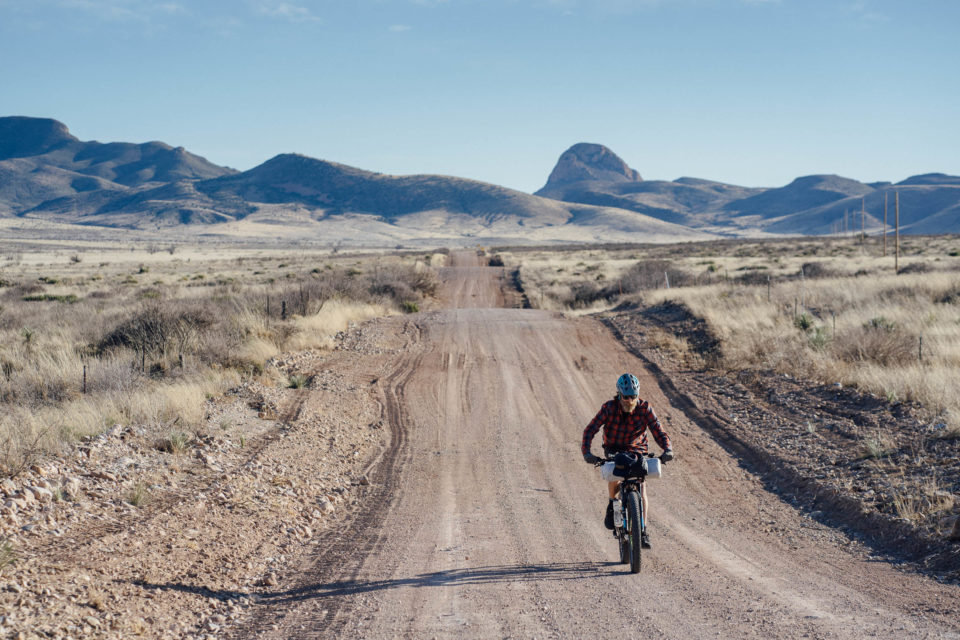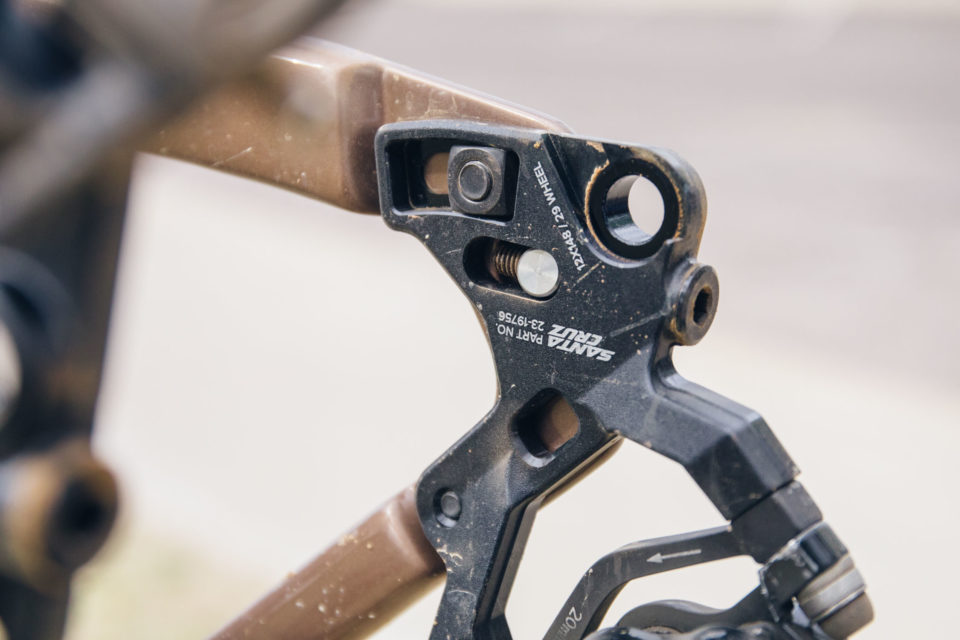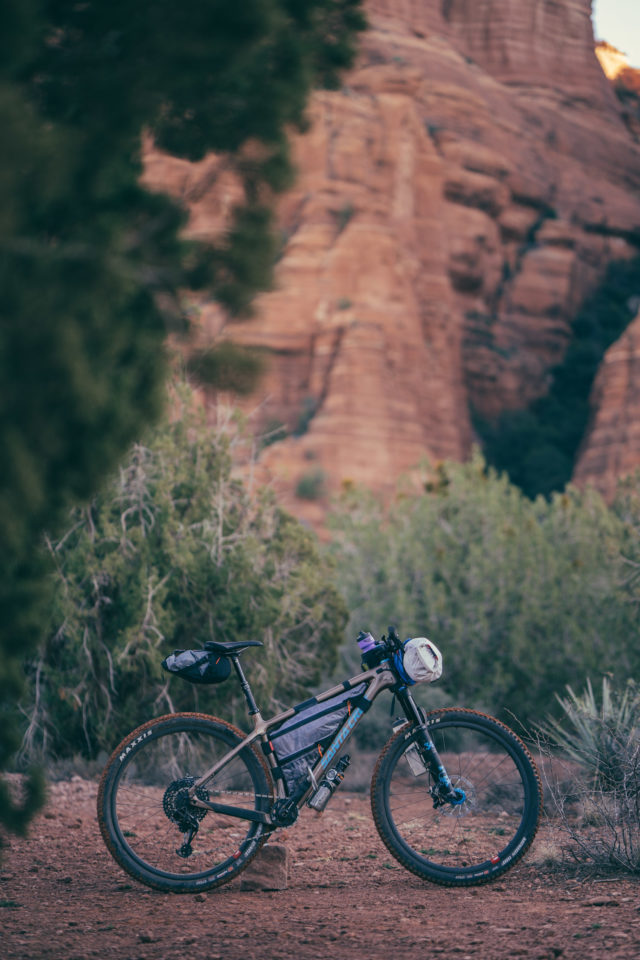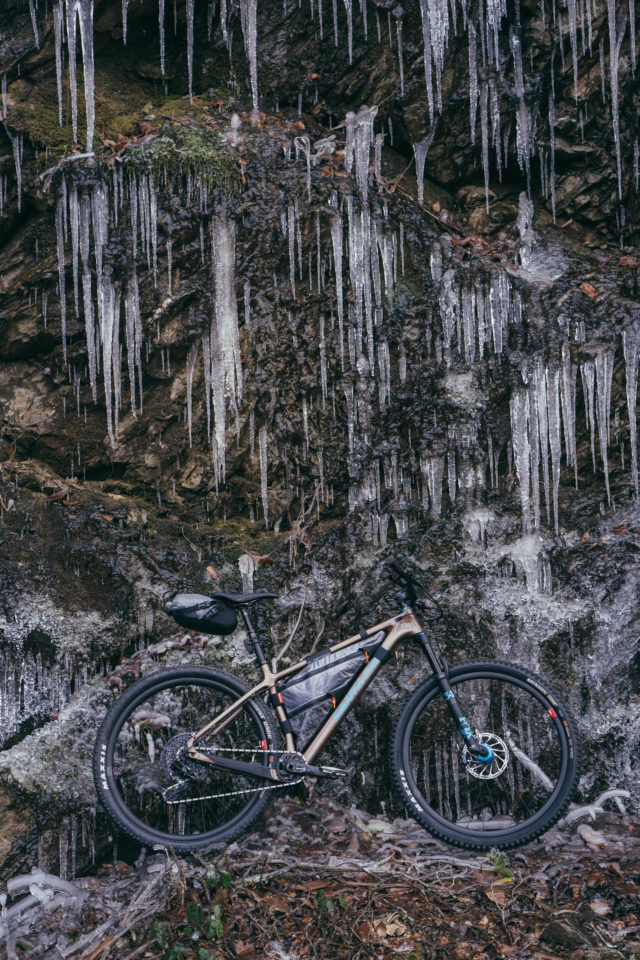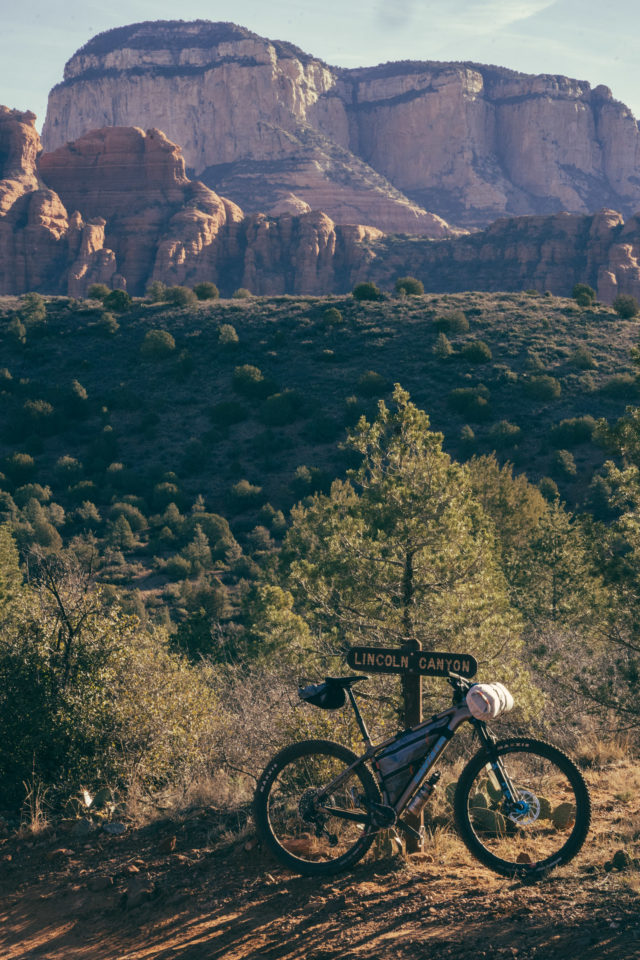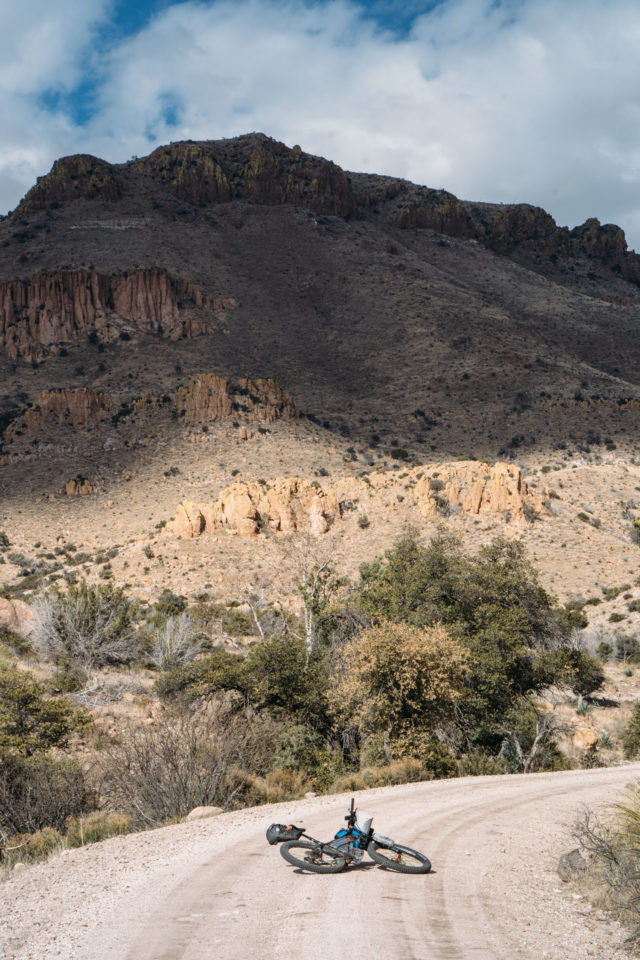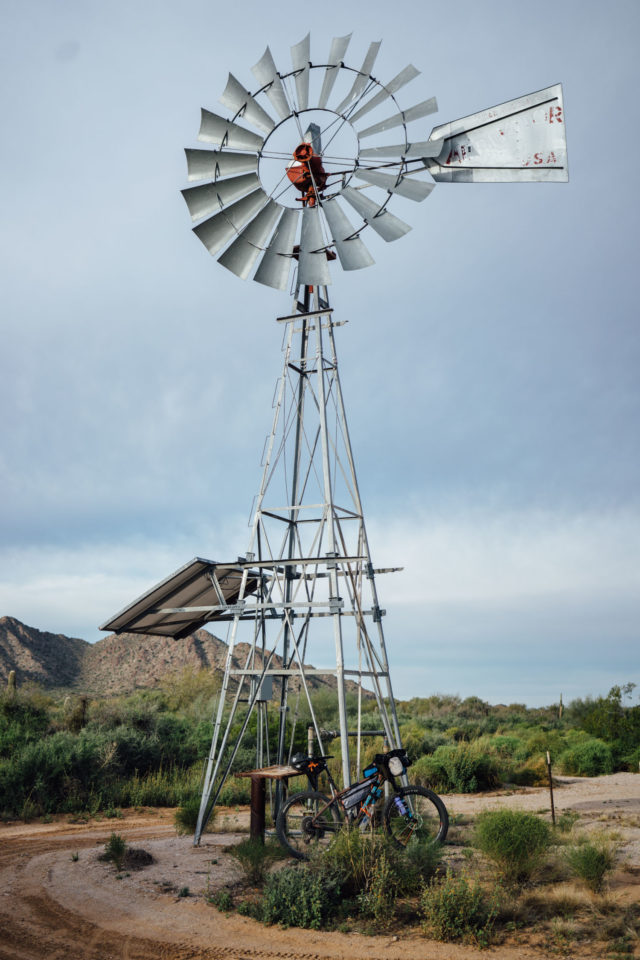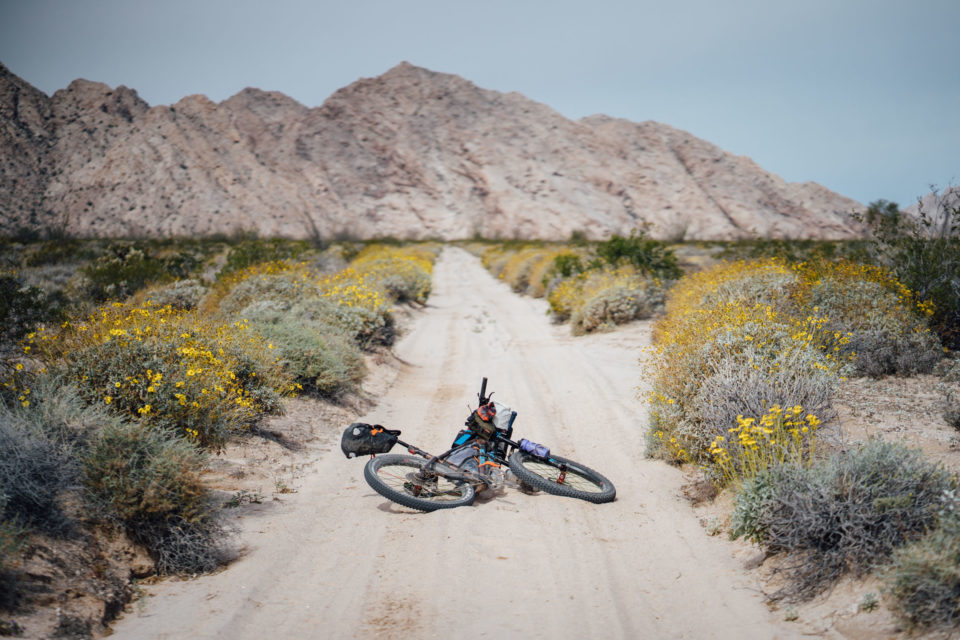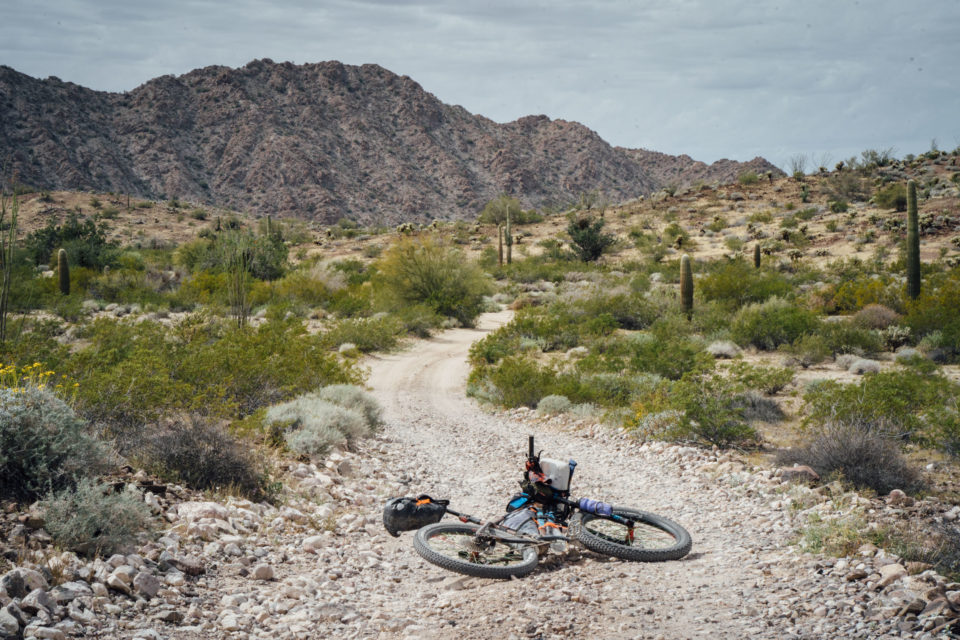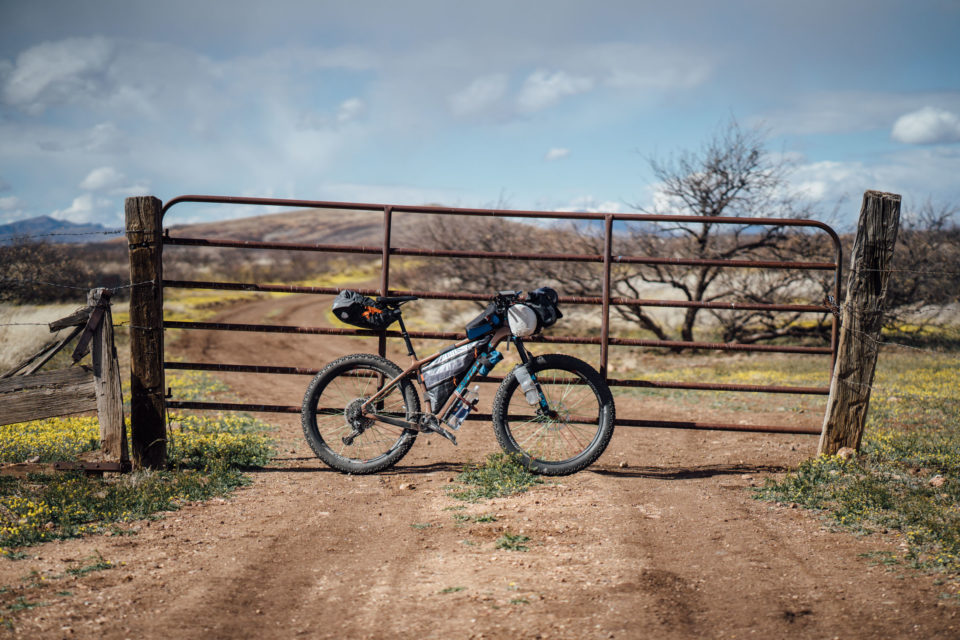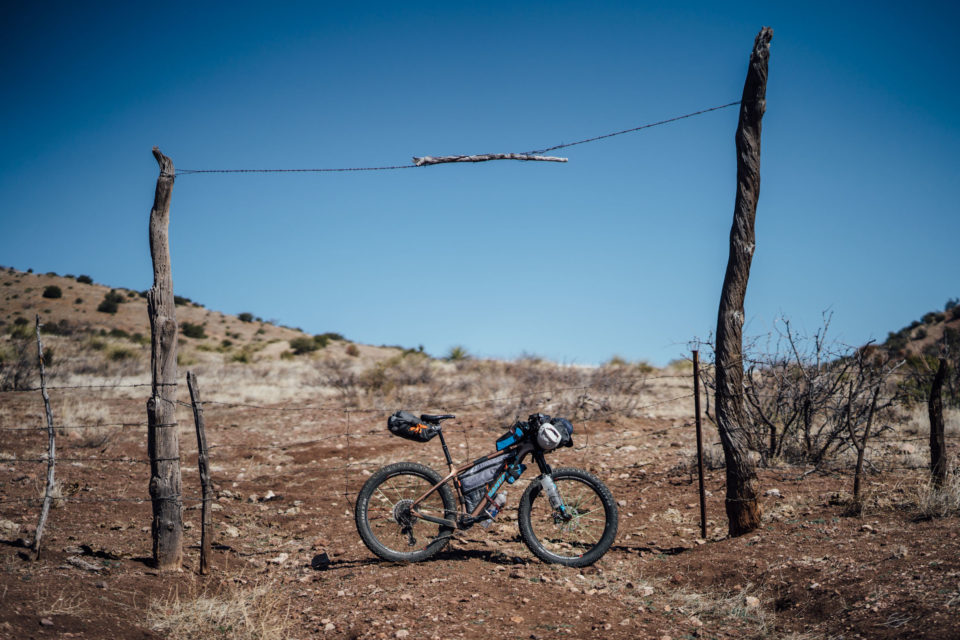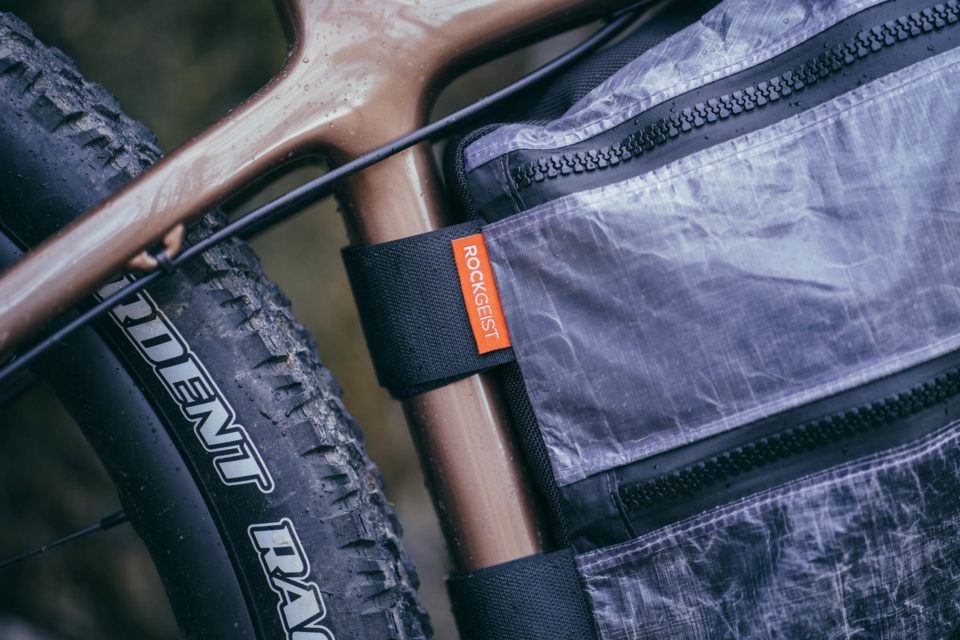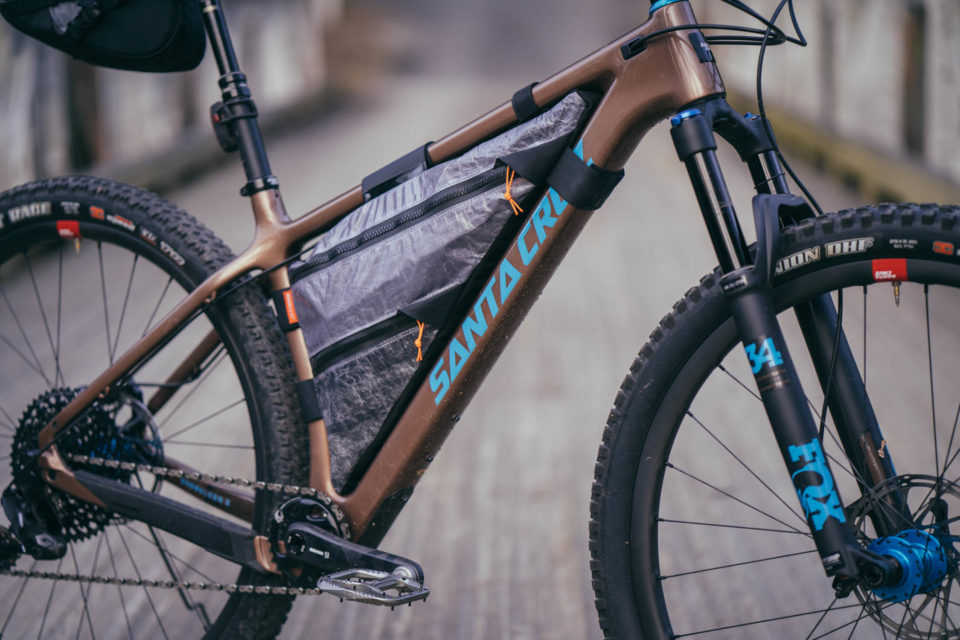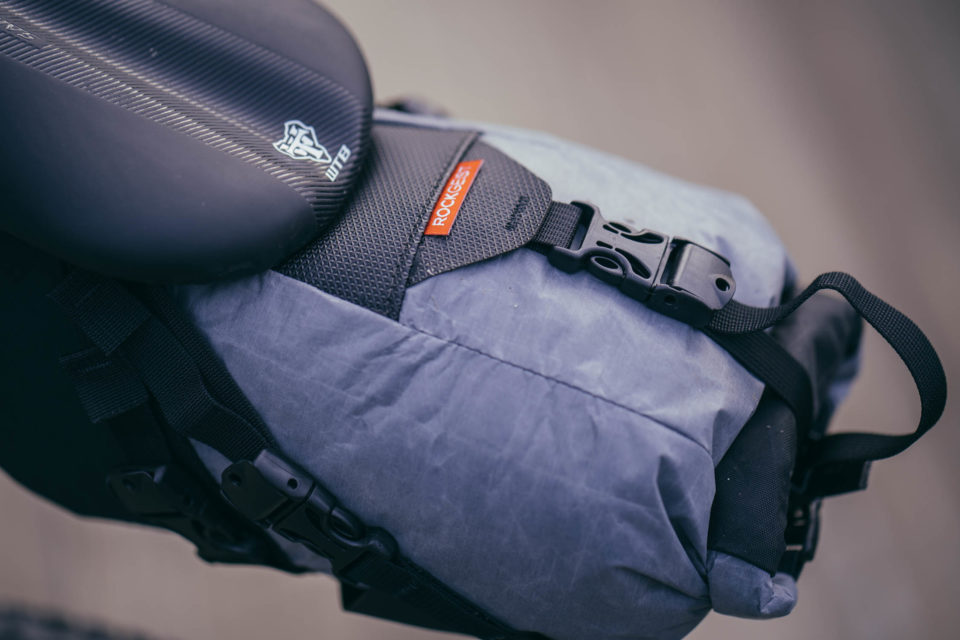Santa Cruz Carbon Chameleon (C): Full Review
Share This
After spending several months with the Santa Cruz Carbon Chameleon in both 27.5+ and 29er mode—clocking in over 1,500 miles of bikepacking and trail riding—here’s the full review. Find a deep dive into details, specs, impressions, and new photographs from several trips.
Originally released back in the mid-late 90s, the Santa Cruz Chameleon (aka Tin Lizard) has seen several upgrades and reiterations over the years. The original was created to morph between a freeride hardtail and single speed XC rig, and everything in between–hence the name. Since then, the Chameleon has evolved a few times (eight, to be exact), but it’s always been all about versatility. Released in 2017, the aluminum seventh version was designed to change its colors from a trail hardtail to a bikepacking steed, according to Santa Cruz. To do so, it featured swappable dropouts that enabled it to run 29er or 27.5+ tires equally well. We never got a chance to try one, but Santa Cruz recently sent us a demo of the eighth edition, which carries over the 27.5+/29er capability as the Carbon Chameleon (Chameleon C).
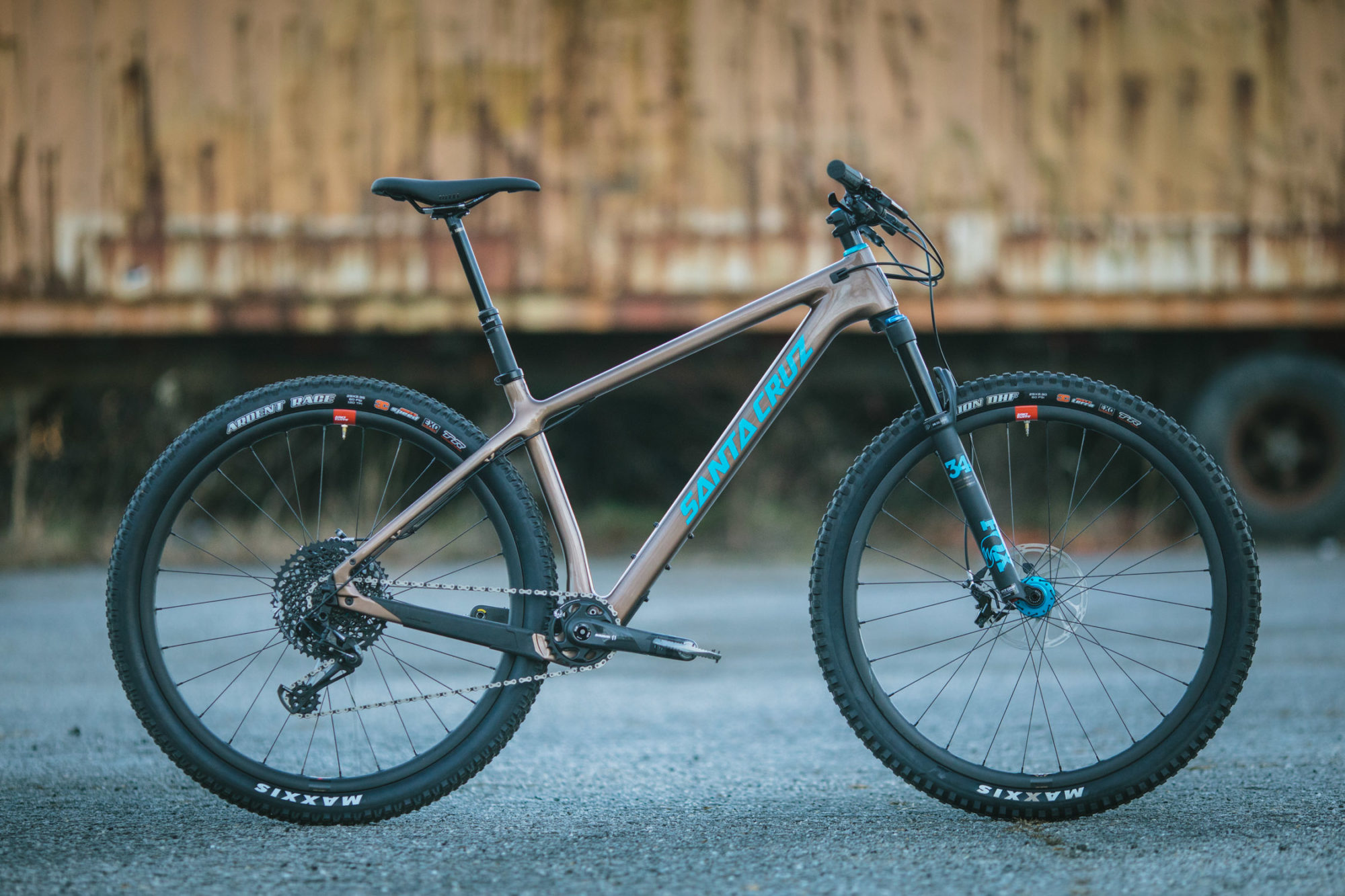
- Highlights
- Angles: 67.3° Headtube, 72.8° Seattube
- Chainstay: 415-430mm
- Bottom Bracket: 73mm threaded
- Hub specs: 15 x 110mm (front); 12 x 148mm (rear)
- Seatpost Diameter: 31.6mm
- Max Tire Size: 27.5 x 3.0″ / 29 x 2.5″
- Weight (as tested): 27.02 lbs (12.26 kg)
So what exactly is the Santa Cruz Chameleon C, and who’s it for? In essence, it’s a high-end trail hardtail aimed to hit a storybook sweet spot between lightweight XC bike and rowdy tough trail rig. It’s designed around an unassuming 120mm travel fork—130mm in Plus mode—but with a relatively slack front-end and a long stance, it feels more like trail bike than the fork might exude. Is the Chameleon C the ideal bikepacking hardtail for races such as the Colorado Trail and AZT? A very strong maybe.
What’s Changed?
Aside from the fact that the new Chameleon C has a snazzy bronze/blue paint scheme, one might think Santa Cruz simply remolded the 2017 aluminum version in full carbon. However, it turns out that Santa Cruz fiddled under the hood with Chameleon C’s geometry for number eight. Nothing major, but they did cut a few millimeters here and add a few more there. Most notably, the Carbon Chameleon got an 8mm higher bottom bracket. Although I haven’t tried the aluminum version, I’ve found the current clearance to be spot on. The C also has a slightly shorter reach and a hair slacker head tube angle, resulting in an 8mm longer wheelbase. There are a few other minor tweaks, such as a 4mm shorter reach and a 3mm higher stack, but otherwise, it’s generally the same creature, aside from the build.
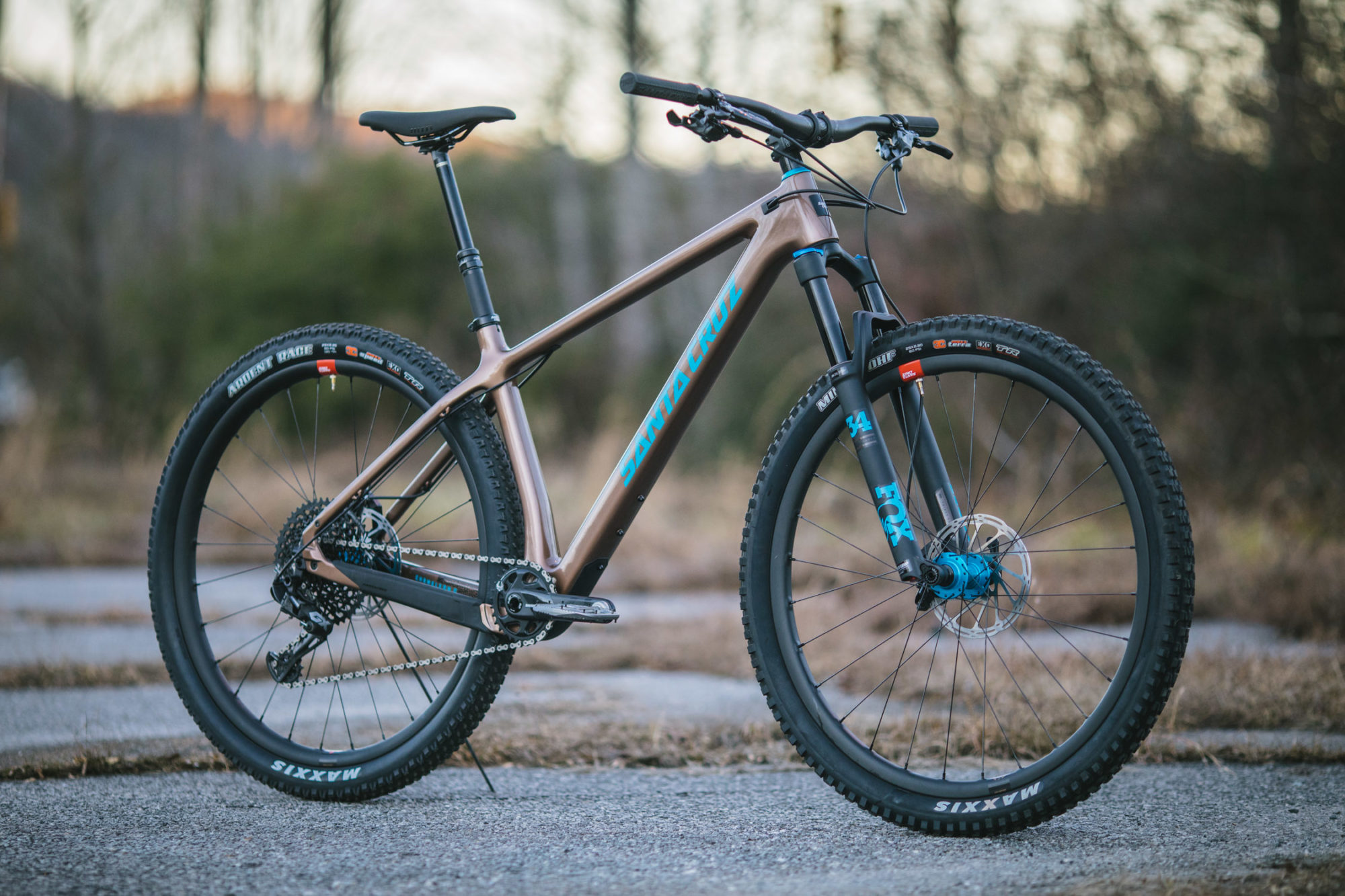
Other frame features include internal cable routing up front that goes external at the rear end. The new Carbon Chameleon also gets a triple-pack of bottle bosses under the downtube, a nice touch for added utility.
29er, 27.5+, and/or Singlespeed
As with the 2017/2018 alloy version, the Carbon Chameleon can be set up as a 29er or 27.5+, geared or single-speed via the same clever modular dropouts, each with a built in chain tensioner. There are four different swappable dropouts: Boost 27.5+, Boost 29er, 142×12 Singlespeed 27.5+, and 142×12 Singlespeed 29er. This interchangeable system enables the Chameleon to maintain the same frame geometry and the BB height regardless of wheel size. Note that Santa Cruz also switches from a 120mm fork to 130mm in the plus tire builds to maintain the same angles.
We’re testing the Carbon Chameleon setup in 29er mode, but as you can see in the photos below, there looks to be a lot of clearance. I’ll also be trying it out with 27.5+ wheels, so stay tuned for more there.
Santa Cruz Chameleon C SE Build
The carbon Santa Cruz Chameleon C is offered as a frame only for $1,599, in S or S+ builds for $3,799, or SE/SE+ for $5,699. We’re testing the 29er SE build with custom blue Hope hubs and headset, Santa Cruz Reserve 27 carbon rims (the 27.5+ SE+ gets Reserve 37). The build kit offered on the high-end SE is pretty well dialed, especially the Float 120mm fork, Eagle drivetrain, carbon hoops, and quick engagement Hope hubs. Here’s the full build, as tested:
Overall, I found the the carbon SE build to be well appointed—namely the important bits like drivetrain and wheels—but it’s not without a few bugaboos. For starters, although I was content with the Fox 34 fork, I found myself wishing there was a Pike up front. I admittedly have a hard time tuning the Fox 34 to my liking and it seemed to become maladjusted after a few months of riding. Then again, that’s mainly a personal preference, as I’ve recently developed a fondness for the plush top-end and supportive mid-stroke that I’ve found in the Pike.
Another quibble was one I expected—I’ve had issues with SRAM Guide brakes on several bikes. The rear developed a bit of softness and required a bleed early on. Then it started howling. And even after sanding the disc and tuning it several times, it never quite went back to normal. Lastly, I would have preferred a different rear tire. The Maxxis DHF up front was perfect for most of the riding I do. However, the rear Ardent Race lacked the grip to maintain traction while wrenching up super steep, rubbly climbs that are common along Arizona singletrack. This slippage was even more evident when the rear wheel was slammed forward via the sliding dropouts. As is common with bikes I like, most of these particular component quibbles only showed their face after a long time with the bike and certainly aren’t deal breakers.
My favorite components on the SE build are the wheels. WIth Santa Cruz Reserve 27 carbon rims laced to nice Hope Pro 4 hubs (8.2° of engagement), they are likely one of the main culprits behind the bike’s steep price point. But, in my opinion, if you have the dough, carbon hoops are one of the most worthy upgrades you can make to a trail mountain bike these days. Lower rolling weight and a more nimble feel make light wheels quite the game changer. That said, for those eyeing this bike with 2.5” 29er tires in mind, the 27mm internal width rims might be a hair narrow; Reserve 30s would be preferable.
- FRAME Carbon C 29/27+ Hardtail
- FORK FOX 34 Float Performance, 120mm, 29″
- R. DERAILLEUR SRAM GX Eagle, 12spd
- SHIFTERS SRAM GX Eagle, 12spd
- CASSETTE SRAM XG1275 Eagle, 12spd, 10-50T
- CHAIN SRAM GX Eagle, 12spd
- BB SRAM DUB 68/73mm Threaded BB
- HEADSET Hope Integrated Headset
- REAR TIRE Maxxis Ardent Race, 29″x2.35″ EXO TR
- FRONT TIRE Maxxis Minion DHF, 29″x2.3″ 3C EXO TR
- SEALANT Stan’s Sealant
- TAPE BMD 30mm Rim Tape
- FRONT HUB Hope Pro 4, 110×15, 28h
- RIMS Santa Cruz Reserve 27 29″ Carbon Rims
- SPOKES DT Swiss Competition Race
- REAR HUB Hope Pro 4, 148×12, XD, 28H
- FRONT ROTOR Avid Centerline 180mm
- REAR ROTOR Avid Centerline 180mm
- BRAKES SRAM Guide R
- CRANKSET SRAM X1 Eagle 148 DUB, 30T – 170mm (XS-S), 175mm (M-XXL)
- HANDLEBAR Race Face Aeffect R
- STEM Race Face Aeffect R, 50mm
- SADDLE WTB Silverado Pro Saddle
- SEATPOST RockShox Reverb Stealth, 31.6
- GRIPS Santa Cruz Palmdale Grips
Carbon Chameleon Fully Tested
When we last left off (this post was formerly ‘to be continued’), I had about 200 miles on the Carbon Chameleon. I now have over 1,500 on it, about 600 of which came from two bikepacking route scouting missions using a 27.5+ tire set up. In the meantime, I’ve also demoed several other hardtails, so I feel I have a pretty good handle on this bike. Find more thoughts, additional photos, pros and cons, and a comparison to several other hardtails below.
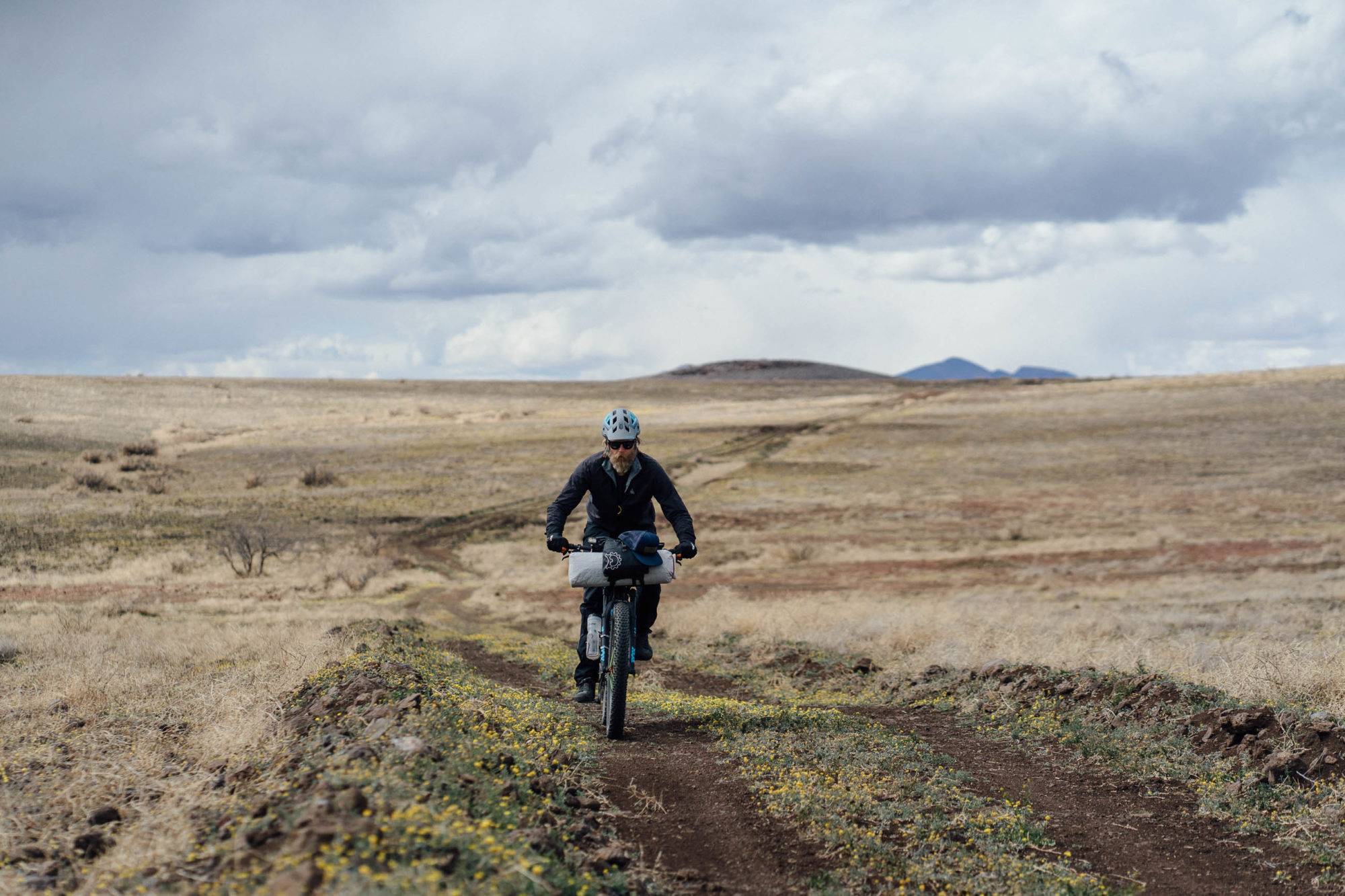
Boards, Bikes, and Trends
At some point in my youth I owned a couple of early Santa Cruz skateboard decks. And if that doesn’t reveal my age, note that one of them had “Rob Roskopp” printed on its psychedelic underside. For those unaware, Rob is the legendary skateboarder who founded the bicycle company of the same name (with a similar visual brand identity). At any rate, I’ve always felt a little attached to this bay area brand, so it’s a little odd that the Carbon Chameleon was the first bike from Santa Cruz that I’ve ridden, save a couple parking lot laps on Virginia’s old alloy Superlight 29er.
If nostalgia doesn’t suck you in, another thing to like about Santa Cruz is that it was founded on the principle of ignoring trends; and, it continues to do so on some level. In 1994, Santa Cruz Bicycles launched with a single bike, the Tazmon, a single-pivot dual suspension bike. At that time, full-suspension bikes were highly irregular, so Roskopp showed his cards from the get go.
These days, Santa Cruz’s innovations are a bit more conservative, but the company continues to buck trends. One such example is its stalwart position to maintain the threaded bottom bracket standard on its mountain bikes. With many big MTB brands introducing numerous press-fit standards over the past decade, mountain bikers were force-fed PF bottom brackets with the industry holding the spoon. Although not outspoken on the subject, Santa Cruz is likely having a “told you so” moment as many companies return to threaded shells.

Master of Geometry
There are a handful of companies that have developed a dedicated fan base through their caliber of bike frame geometry. Santa Cruz is one such institution. Ever since the Blur was released in the early 2000s, Santa Cruz bikes has cultivated a devout following, most of whom attribute their devotion to the well-conceived angles and ride quality that SC’s bikes exhibit. Having heard this for years, I was pretty excited to try the new Carbon Chameleon, a somewhat progressive hardtail—a type of bike that I’d consider my goldilocks—with a geometry that Santa Cruz is clearly proud of.
When creating the Carbon Chameleon, Santa Cruz no doubt followed one popular trend—a 29er hardtail that magically transforms to 27.5+ with versatility as its main marketing pitch. However, while many bikes in this category ignore the geometric impact of switching between these two tire sizes, Santa Cruz stuck to their guns and made no sacrifices. Perhaps they are equally as staunch about geometric precision.
As with the 2017/2018 alloy version, the Carbon Chameleon’s suite of clever, swappable dropouts allow the bike’s transformation from 29er to 27.5+, or geared to single speed, each with a built-in chain tensioner. There are four different dropouts: Boost 27.5+, Boost 29er, 142×12 Singlespeed 27.5+, and 142×12 Singlespeed 29er. This interchangeable system enables the Chameleon to maintain its exact frame geometry and BB height, despite the variation in wheel/tire size. Note that Santa Cruz also switches from a 120mm fork to 130mm in the plus tire builds to maintain these same angles. Instead of sacrificing several millimeters here and there when switching tire/wheel sizes, the Chameleon is steadfast in its stance.
I’ve tried a lot of trail hardtails over the last few years and the Carbon Chameleon is one of my favorites. When compared to the Kona Big Honzo CR and the Why Cycles S7, two other bikes I really liked recently, the Carbon Chameleon shares a few geometrical similarities, but it’s also quite different. It’s strikingly dissimilar from the Kona. For one, it has a slacker, curved seat tube (72.8° vs 75° on the Kona and 73° on the Why); this, along with its drop chainstay, give the Chameleon a shorter chainstay length and a little more over the rear wheel feel. I kept the pivoting dropout in the short setting when it was set up as a 29er for trail riding—415mm, as opposed to 430mm on the Kona and 425mm on the S7 when slammed forward.
That brings up the one complaint I have with the Chameleon’s geometry. Note that this is unique to me and other (averagely tall) people with a 34”+ inseam who are still short enough to not be able to ride an XL frame. That is the fact that the effective seat tube angle actually slackens when the post is jacked up to accommodate my giraffe legs. This didn’t really affect the feel of the Chameleon while descending, of course, but I could feel it when climbing up steep climbs while seated (as I can with many other carbon bikes with curved seat tubes). Namely, it moves more of my body weight rearward, changing the leverage and making it harder to keep the front wheel on the ground. I also tend to feel the effect of this in my knees after a while. But the bike wouldn’t feel the way it does without that curved seat tube. All that said, based on the geometry chart below, it appears as if SC specs the angle based on the curve, and not a straight line line from the center of the bottom bracket to the seat post tube top/center (as most bike companies use). This would mean that the Carbon Chameleon has a steeper angle than specced, especially for shorter riders.

All that said, I found the overall geometry and stance of the Carbon Chameleon to be quite pleasant. Note that its geometry chart leans toward the conservative end of the spectrum; after all, it is intended to sit somewhere between XC and “trail” with the intention of being used for a range of riding styles, including XC racing, bikepacking, and day-to-day singletrack shredding. While I didn’t tackle the former with the Carbon Chameleon, I can confidently confirm that it’s damned good at toggling between the latter two tasks. It’s a great bikepacking rig, and it shines as a trail hardtail.
That brings up one thing I really appreciate about riding a hardtail: that ninja-like feeling that they provide when trail riding. On a hardtail, your approach to the terrain is completely different than it is on a full-suspension rig. You generally have to always be on point, making calculated decisions and feeling the trail in an almost meditative state. For me, if I had to have only have one bike, it would be a hardtail for this very reason. And it doesn’t hurt that they’re far more utilitarian and require less service than more complicated full-squish bikes.
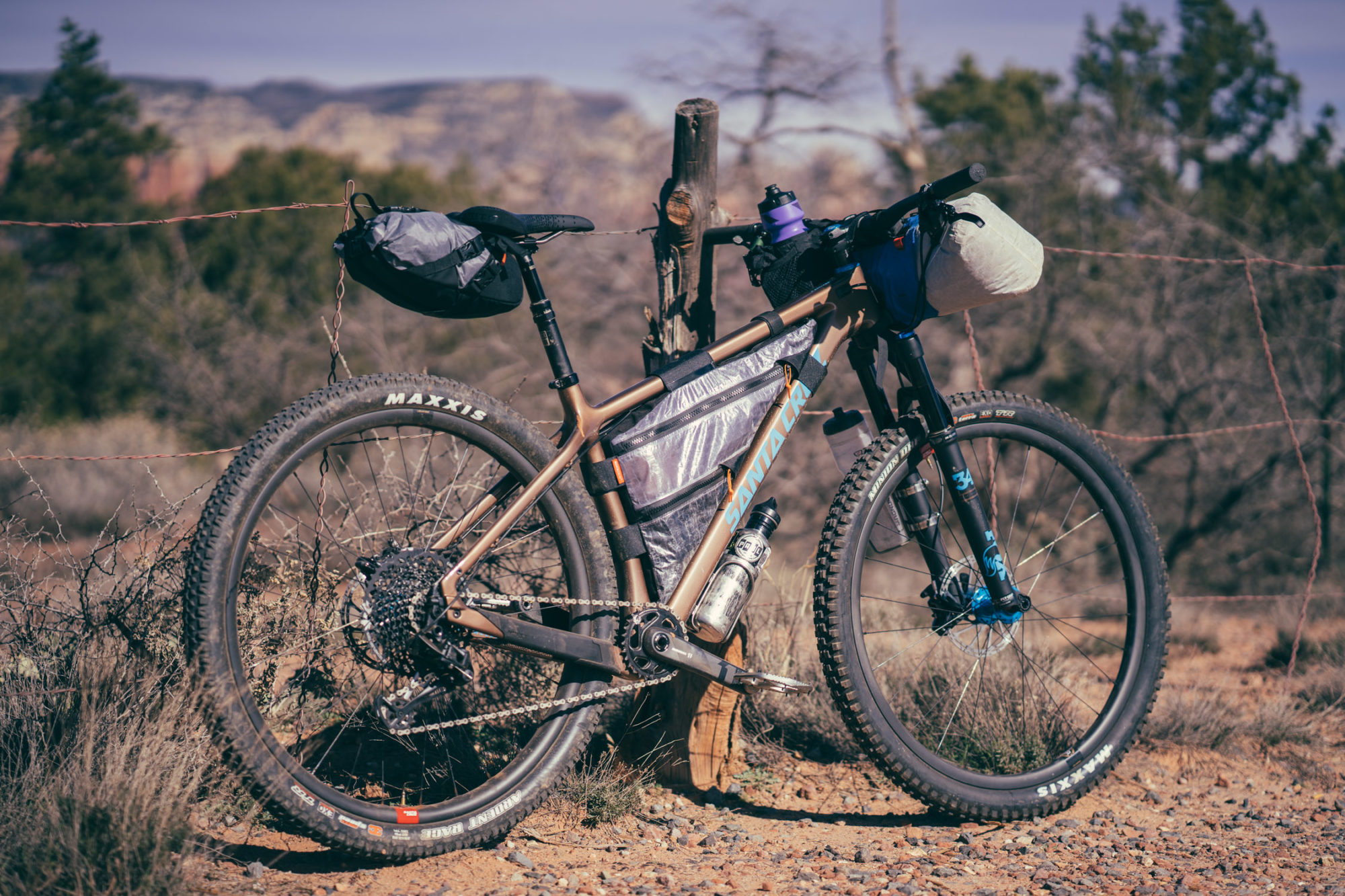
Carbon Chameleon as a 29er
As I mentioned in the first ride report, this bike is surprisingly capable as a standard tire 29er. I’ve put a ton of singletrack trail miles on it with the 2.3/2.35” tire combo that it ships with—from the rooty, rocky trails of Pisgah to the twisty, technical singletrack of Sedona, including all the Hogs, the Western Trails, as well as chunky goodness of Scorpion, Ridge, and Sketch. It’s also been on the Black Canyon Trail, Tucson’s edgy singletrack, and a couple hair-raising trails around Santa Cruz, CA. In addition, I took it out on a 45-mile overnighter around Sedona as a 29er.
My impressions are different based on the terrain, of course. In Pisgah—a place that many folks think should be reserved for full-suspension bikes—I found the carbon frame a little stiff and somewhat bone-rattling, and wished for bigger tires. The 29 x 2.3/2.35” combo is nice and certainly kept the Carbon Chameleon light and nimble. But, over the past couple of years I’ve really come to appreciate the added traction and suspension that 29 x 2.6” wide trail tires offer, especially on a short travel bike or hardtail. I think 29 x 2.5” tires could be quite good on this bike as well, so I don’t think the 29 x 2.5” rear tire clearance limit is a deal breaker. In Sedona, where the trails are a little more flowy and require nimble tech maneuvers, I absolutely loved this bike as a standard 29er. For lack of a better analogy, it floats like a butterfly over this terrain. I was equally impressed when it was loaded up; the carbon almost came to life under load. After a while with it, I adapted to the frame and don’t think the Carbon Chameleon frame is too stiff at all. In fact, I would confidently say that the carbon layup used on this frame is really well balanced. I kept trying to find things I’d change about the frame, but I simply couldn’t.
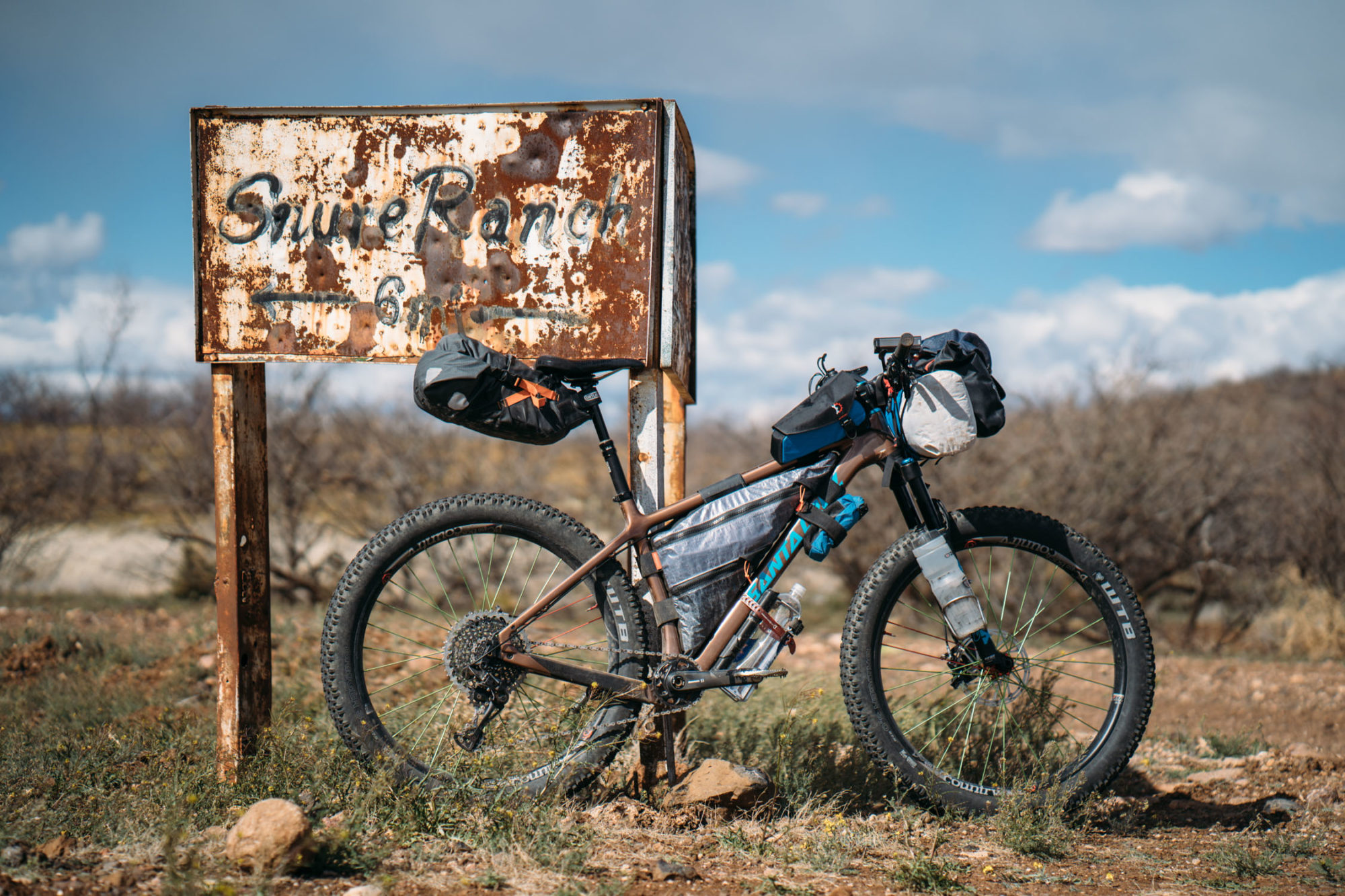
Charbon Chameleon in 27.5+ Mode
Santa Cruz sent me a pair of the 27.5+ dropouts to give it a try with that wheel/tire size. I swapped the stock 29” wheels with a pair of I9 BC450s on several occasions and ended up racking up almost as many miles on the Carbon Chameleon in its huskier 27.5+ guise. I didn’t have the luxury of swapping to a 130mm fork when in 27.5+ mode, as Santa Cruz does in its complete build, so I ran it with the stock 120mm fork. That didn’t make much difference, really. If anything, it steepened the angles a tad to make it a little more long-distance friendly.
On my first big bikepacking trip after making the switch, I left the 3.0” WTB Bridgers mounted to the 45mm rims. The Bridgers are a full three inches wide, maybe even a little more. They only left about three or four millimeters of space between the tire and both chainstays at the yoke. I noticed a little rub with mud and debri in the tire so I switched to a 2.8” Icon for the second trip, which gave it a little breathing room.
Broadly speaking, the Chameleon felt similar as a 27.5+ hardtail, with the added benefits you’d expect from plus tires (extra traction, floatation, and cushion), as well as the cons, such as added rolling resistance. However, I mostly used it on doubletrack roads, sand roads, and jeep tracks in this setup, and kept the dropouts adjusted to their most rearward position, giving the bike a 430mm chainstay length and providing a more pedal-friendly, stable stance. This made a noticeable improvement, and as a dirt-road bikepacking rig, it was surprisingly comfortable while pedaling for 60+ mile days.
- Model Tested Santa Cruz Carbon Chameleon SE (29er/size large)
- Weight (as tested) 27.02 lbs (12.26 kg)
- Price $5,699 USD
- Rider height/inseam 6’0″ (1.83m)/34
- Place of manufacture Taiwan
- Manufacturer’s detail SantaCruzBicycles.com
Pros
- Dialed geometry makes it well-balanced and highly maneuverable on the trail
- Adjustable/pivoting dropouts allow you to change the bike’s chainstay and wheelbase depending on the type of riding you’ll be doing; this is especially interesting for tweaking between trail riding and longer bikepacking outings
- Swappable dropout inserts maintain the bike’s intended geometry for both 27.5+ and 29er wheels/tires
- SE build is really nice, though expensive
- Three-pack mounts under the downtube; take note, other hardtails!
- Nice color and graphics
Cons
- Expensive, especially for a hardtail
- Wish it cleared 29 x 2.6” tires (and had swappable dropouts for that configuration)
- Curved seat tube creates a slacker effective seat tube angle for long-legged folks, like myself; but, then again, without that, you couldn’t have that sweet 415mm chainstay length
Wrap Up
I put in quite a bit of saddle time—as well as a lot of effort tweaking the setup—to properly pick apart the Carbon Chameleon. I exclusively brought the Chameleon out to the Western US as my only mountain bike for an extended work/play trip this winter. It doubled as my primary trail bike and bikepacking rig and ultimately performed on a very high level in both scenarios. I didn’t really want to give it back. Admittedly, Santa Cruz was nice enough to tell me I could hang on to it for a while, but since I passed through the town of Santa Cruz, I went ahead and parted ways with it at that point—something I now kind of regret.
Although I covered a lot in the writeup above, there are probably still a few unanswered questions for those comparing bikes for a long-term investment. Fire away in the comments below and I’ll do my best to answer them. One question will likely be how the Carbon Chameleon compares to other hardtails. The broad and succinct answer is that it’s in the top five hardtails I’ve ridden to date, a list that would be tricky to put in an order of preference. It certainly rides with the best of them, but like the others, it has granular pros and cons to weigh out. The most prominent quibble, of course, is the price tag. And the most unique feature, and its most significant pro, are its swappable dropouts, offering the Chameleon not only multiple wheel sizes, hub specs, and drivetrains, but keeping its geometrical precision at the same time.
All that said, if you’re in the market for a trail hardtail that can double as a bikepacking rig, and do both really well, the Carbon Chameleon should probably be on your list.
Photos above show the Chameleon C decked out with an ultralight kit. The bolt-on, custom, Cuben fiber frame bag was provided by Rockgeist alongside a matching Gondola dropper-specific seat pack.
Please keep the conversation civil, constructive, and inclusive, or your comment will be removed.






